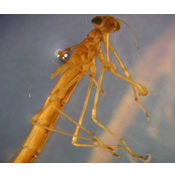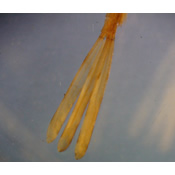| Distinguishing Characteristics | |||||||||||||||
|
|||||||||||||||
| Additional Pictures | |||||||||||||||
|
|||||||||||||||
| Ecology | |||||||||||||||
| Habitat
There are 2 Genera found throughout North America, Archilestes and Lestes (3). Archilestes sp. larvae inhabit slow flowing stream environments, although Archilestes grandis can be found in pools (2, 3). Larvae of Lestes are found in lentic environments, such as vernal pools and marshes, although occasionally inhabit standing water areas of slow moving streams (2). Both genera regardless of water type are found in vegetation (1, 2, 3). Certain Lestes species will only occupy temporary water bodies while others are permanent pond species (4). L. eurinus is one species that will only live in fishless permanent ponds (4). Life History Temporary water body Lestes species lay their eggs in the summer, which remain in a diapause state until the following spring in which they hatch and the larvae go through a rapid 2-3 month development period. These adults will emerge in the summer. Permanent water body Lestes species however, have a direct egg development in which eggs hatch in the late summer and larvae have a 10 month development period after which emerge as mature adults in the early summer (4). All North American Lestidae species are univoltine (5). Feeding Ecology Many Lestidae larvae are cannibalistic predators, feeding on individuals within the same species that are smaller (6). Other Lestidae larvae consume soft-bodied invertebrates such as mayfly larvae (7). Lestidae species also serve as prey for fish and other predatory insects (8). Certain Insects, including Nonecta have adapted to the ability of Lestidae larvae autotomizing their lamellae by striking the main body regions thus avoiding the lamellas (8). Physiological Ecology Larvae can autotomize their lamellae to escape predation by breaking the attaching joint when grasped by a predator (6, 9). Lamellae are also used in gas exchange, which aids in respiration during times of oxygen stress (8). Although Lamellae can be replaced in 2 to 3 molts, the multiple uses for lamellae put larvae at increased risk for predation when one or more lamellae are missing (6). L. sponsa larvae have been observed in cannibalistic behaviors. The study reported that species missing a lamellae were consumed three times more often than species without lamellae missing (6). Other Lestidae larvae have a Hilsenhoff tolerance value of 9. This high level of tolerance to water qualities allows them to be a competitive predator in numerous water bodies (3). Their preference of soft bodied prey has shown that they can greatly reduce mayfly population densities (7). |
|||||||||||||||
| QuickTime Movies | |||||||||||||||
| Additional Links | |||||||||||||||
| Bibliography | |||||||||||||||
|




